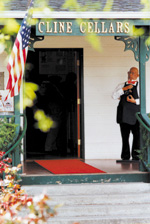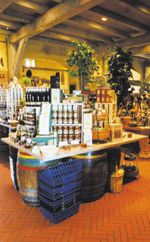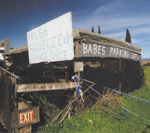| Appellations | |
| Carneros Confidential | |
|
|
This is a place full of secrets. Squirrelly two-lane roads that
lead God-knows-where, wineries tucked away behind huge stands of
eucalyptus, and a vast stretch of boggy, muddy, ochre-colored mire
that would make the Hound of the Baskervilles right at home. This fertile crescent straddling Napa and Sonoma wine country is
bounded by earth and water, dominated by sky and filled with the
sounds of songbirds, wild ducks, sheep and ceaseless wind. Here
the saltwater of San Pablo Bay gives way to ancient, serpentine
waterways lined in cattails, red-winged black birds, fairy shrimp
and gleaming wetlands. The cool, constant temperatures provide a long, leisurely growing
season for both of these early-ripening varieties. Winemakers here
find more than just comparisons to the Champagne region of France. Carneros winemakers are not under the pressure of other growers
in other regions of the world, that of rainfall. “Unlike France, the end of our season is not usually determined
by rain,” says Michael Terrien, winemaker at Acacia Winery.
“We have the great luxury here to ripen the fruit well.” Carneros is one of the oldest grapegrowing regions on the West
Coast. Wine grapes were first planted here in 1830 and the first
winery was established in 1870. Its early viticultural fortunes
fell first with the spread of the root louse phylloxera in the late
1800s and then with the onset of Prohibition in 1918. By the 1970s,
however, it was back on the winemaking map. Even though the area includes numerous recognized wineries such
as Cline Cellars, Saintsbury, Artesa, Buena Vista and Viansa, it
still receives far less attention from wine country visitors than
neighboring wineries to the north. “We’re just being discovered as a destination,”
says Nan Campbell, executive director of Carneros Quality Alliance,
a group of vintners and grape growers who promote the region. “A
lot of people miss us as they drive through to other places.” “It’s a double-edged sword,” she says of the potential
of increased numbers of wine lovers. “You can still ride your
bikes on the road here. Our idea of a four-star restaurant is Babe’s
Burgers and Franks. We’d love to see more visitors, but we
would also like Carneros to remain an off-the-beaten-track gem.” Babe’s is the culinary center of Carneros. For 18 years the
no-nonsense women behind the counter of this roadhouse café
on Hwy 121-12 have been perfecting the double bacon cheeseburgers
that makes Babe’s the French Laundry of this stretch of asphalt.
The beef patties are thick and juicy. The onions are zingy and the
American cheese is persimmon-colored Elmer’s Glue. Ask for
the secret of a great burger and you’ll get the same advice
Julia Child would offer any aspiring sous chef: fresh ingredients.
Burgers are served every day except Wednesday, starting at 7AM.
Here, surrounded by some of the most spectacular vineyards on the
planet, ask for Ice Tea with your lunch. Ask for Dr. Pepper or Lemonade.
Don’t ask for wine; they’ll just laugh. (At you, not with
you.) It’s that kind of place. “We’re so much more than farming grapes and making wine,”
says Campbell of the region. “We’re an incredible ecosystem.
We’re right on the Pacific flyway so the area is home to migratory
birds.” Beyond vineyards and wild life, there are biplane rides at the
Sonoma Valley Airport, artwork for sale and small specialty shops
such as Angelo’s, with its selection of sausage, bacon and,
most of all, jerky. The Carneros Quality Alliance has produced a new wine country “field
guide” to this appellation complete with colorful maps, climate
and soil information, and a complete guide to the cluster of wineries
here. The guide is a feast for the eyes, offering stunning photos of the region in its splendor throughout the seasons. The pages are filled with pastoral glimpses of waterfowl, cows, hay fields, vineyards and even muddy sloughs. It’s also a treasure trove of information about the land, its seasons and cycles, and its complex web of life. It is available at most Carneros wineries on the Carneros Alliance web site. Point your browser to www.carneros.com. |




